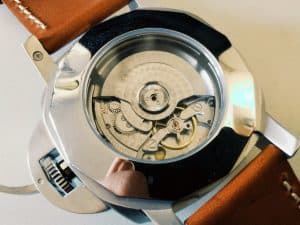The age-old question keeps getting asked “What’s the Difference With Manual Wound Vs Self Wound Automatic Watches?” we answer this question in this updated 2024 guide.
When talking about a mechanical watch, you can find it in two basic categories.
It is either automatic or manual mechanical watch.
To reserve and conserve power, it is crucial for a manual watch to remain hand-winding.
The opposite of this scenario works for automatic mechanical watches.
In a nutshell, the concept of self-winding is crucial to an automatic watch.
What are the differences between a self-winding and hand-wound watch?
Many people often don’t care about the movement of watches.
The movement, design and other important features can help when buying a wristwatch.
Keep reading this content to know more about self-winding and hand-wound watches.
History Of Both Watches:
For people who like fine watch craftsmanship, hand-wound watches remain appealing.
Without any iota of doubt, the technology running hand-wound watches remain durable.
This type of watch has the capability and durability to stand the test of time.
1776-1777 marks the beginning of the reign and use of automatic movement watches.
Abraham-Louis Breguet, a Swiss watchmaker was the first to design an automatic watch.
The difficult inner structure of these movements didn’t make it available to the masses.
The main feature that made the watch unique and a breakthrough is that while wearing it, it can self-wind.
With this watch, you can get an accurate time without stress.
Technical Side Of Manual Vs Automatic:
A Hand-Wound Watch:
One thing is important when talking about hand-wound watches, you will keep winding them for them to keep their time.
The mechanism operating this kind of watch requires you to always wind them up with the help of the crown.
This is the major difference between a hand-wound and a self-winding watch.
In the case of a self-winding watch, you are not expected to wind them by using the crown.
To empower the mainspring movement of this watch, winding the crown is most important.
The make or brand will determine the number of winding to perform on a hand-wound watch.
Some brands have a power reserve of 2-3 days while others will need to be wound up daily for them to have power reserve.
While wearing a manual watch, it is crucial to wind them.
Another important thing to note is not to overwind the watch as it could damage the delicate mechanisms.
When there is resistance felt on your wrist, stop winding hand-wound watches.
The resistance when winding the crown is to show you that the tension of the string is almost up.
If overwound, it could damage the spring, however, the durability and aesthetic beauty of the hand-wound watch is stunning, and makes more watch enthusiasts drool with excitement.
Self-Winding Automatic Watches:
There is a unique half-shaped rotor attached to the automatic movement and It responds to the movement of your wrist.
As you move around the rotor in an automatic watch will swing on a given pivot.
The effort from the rotor helps top up the power reserve time of the watch without winding it.
In fact, most automatic watches have a special technology that keeps them running for a long time.
The glass case back is one of the highlighting features that showcases the movement and see if it is an automatic or hand wound watch.
Pros and Cons About Manual Wound Watches
Pros
- Easy to use
- They may last longer as there are fewer mechanics involved.
- Manual wound watches are usually thinner designs than their automatic counterparts.
Cons
- It can take up to thirty rotations to hand-wind the watch for full power reserve.
- You will have to remember to wind it regularly as it will lose time.
- Maybe judged as an annoying task to wind it up on a regular basis.
Pros of Automatic Self Wound movements
Pros
- Many watch designs incorporate the use of a glass back case to showcase the movement.
- The accuracy of time you get in the automatic watch may be more accurate than manual movements
- They self-wind and top up the power reserve based on the movement of the user
Cons
- Winders are needed if you have a sizeable automatic watch collection. Half the issue of having many automatic watches with complicated date functions and moonphases is that they can be very difficult to set up when you want to wear them.
Summary:
If you’re looking for an aesthetically pleasing and durable and slim wristwatch that can stand the test of time, then a manual movement watch is a great choice.
However, automatic movement watches make life easier and some may say less cumbersome when it comes to their self-winding features.
Either way, both movement mechanisms have their own beauties and pitfalls.
That said, if you strive for a well-rounded collection then it doesn’t matter unless your watch makes you feel good.
What are your views on the manual wound and self-winding automatic watches?
- Top 8 Affordable Automatic Watches – Updated Guide 2024
- Best Luxury Automatic Mens Watches Under $500 – Top List of 2024
- Best Automatic Dive Watches Under $500 – Updated 2024
- How Automatic Watches Work – The Layman’s Explanation
- Types of Watch Movements Quartz Movement vs Automatic 2024
- The DUFA Automatic Bauhaus DF-9016-03 Watch Review
- Circula Automatic Watch Review – Then And Now in 2024


